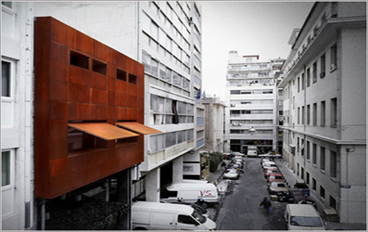WEATHERING STEEL CLADDING, PANELS & FAÇADE WORK
WEATHERING STEEL FACADE WORK



Weathering is popular with architects reason as we assume being materials adaptability to blend in natural landscape with its ever-changing rustic patterns with change in climatic conditions where its installed & simultaneously with urban infrastructure it provides striking finishes that give buildings a modern stylized appearance.
Steel that naturally weathers to provide a stunning rusted look.
Benefits
- Superior aesthetics
- Provides excellent weather protection to the building envelope.
- Virtually maintenance free. No need to paint. Does not require any separate surface treatment. Use of weather resistant steel thus eliminates the need for surface treatments during the manufacturing and operational periods. The only maintenace required is to ensure that the conditions for formation of the patina layer are preserved, i.e. That the corten steel elements are periodically wetted and dried but not kept constantly wet.
- No requirement to treat lowers the environmental load and costs throughout the product's life cycle.
- Self-protecting steel is longlasting.
- Self-protecting steel is economic due to low maintenance.
- Self-protecting steel is easily recyclable.
- High strength-to-weight ratio. This gives the designed the ability to reduce costs through using lighter sections for your project.
History:
Weathering (also commonly referred to as cor-ten) was used in 1971 for an order of electric railcars built by the St. Louis Car Company for Illinoise Central Railroad. The use of corten was seen as cost-cutting move in comparison with the contemporary railcar standard of stainless steel. Most of these railcars still operate today.
Examples of Corten Structures:
- The Angel of the North (UK)
- Arts Complex at Leeds Metropolitan University (UK)
- Matsunoyama Natural Science Museum (Japan)
- The Centre for Contemporary Art, Melbourne, (Australia)
Details
- • Rust-like appearance if exposed to weather for several years.
- Due to the chemical composition, corten steel exhibits increased resistance to atmospheric corrosion compared to other steel. This is because the steel forms a protective layer on its surface under the influence of the weather.
- The corrosion-retarding effect of the protective layer is produced by the particular distribution and concentration of alloying elements in it. The layer protecting the surface develops and regenerates continuously when subjected to the influence of the weather. Therefore, the steel is allowed to rust in order to form the 'protective' coating.
- Formation, duration of development and protective effect of the covering layer on weathering steels depend largely upon the corrosive character of the atmosphere. Its influence varies and depends mainly upon the general weather conditions. In general, the covering layer offers protection against atmospheric corrosion in industrial, urban and countryside climate. In Industrial environments the protective layer forms more rapidly on the steel and darkens more than in cleaner rural environments. The protective patina layer cannot form, however, if the surface of the steel is continuously damp or dirty.
WEATHERING A STEEL PLATES & COILS PRODUCTS & USES | WEATHERING STEEL TUBES & PIPES | WEATHERING STEEL CLADDING PANELS & FAÇADE WORK
| WEATHERING STEEL SCREENS DECORATIVE ART WORK | WEATHERING STEEL INSPIRATIONAL PROJECTS










